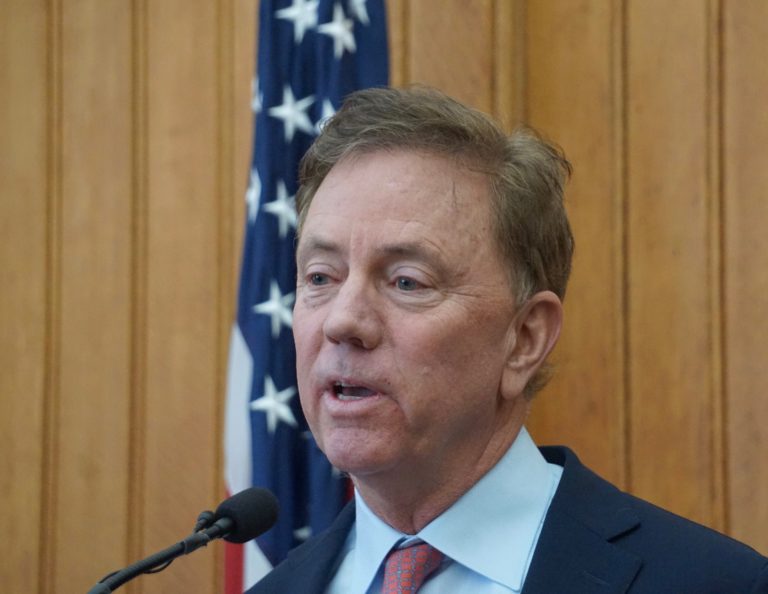Lamont Would Ease ‘Debt Diet’ in Final Push for Tolls

Audio By Carbonatix

Gov. Ned Lamont. Photo credit: Mark Pazniokas, CTMirror.org
The governor may consider additional bonding if $100 million is dedicated to transportation projects, a plan that Democratic leaders may be willing to endorse.
By Keith M. Phaneuf, CTMirror.org
Gov. Ned Lamont is making a final push to salvage tolls this year and its success could hinge on the limit he and lawmakers set on Connecticut’s credit card.
The governor is asking fellow Democrats to consider a scaled-back proposal that would place tolls only in strategic locations – such as aging bridges.
Though full details of the plan were not available late Monday, it would be part of a larger proposal that also would involve Lamont easing up on his planned “debt diet” and accepting about $300 million in additional borrowing in each of the next two fiscal years.
But some of that extra bonding, about $100 million per year, would have to be dedicated to transportation projects.
Senate Democrats have been more wary of tolls than their House counterparts.
But while Senate President Pro Tem Martin M. Looney, D-New Haven, stopped short of endorsing any new proposal, he did say these elements collectively “point us in the direction of a hybrid compromise” that is at least worthy of further discussion.
House Speaker Joe Aresimowicz, D-Berlin, who supports tolls on major highways, said the administration’s willingness to compromise on tolls and borrowing is “a positive step,” adding that “I would be willing to make whatever compromises necessary to come up with a long-term plan to fund our transportation needs.”
Lamont urged lawmakers in February to slam the brakes on state borrowing, recommending slightly less than $1 billion in new general obligation bonding for each of the next two fiscal years.
General obligation bonds are the principal means used to finance municipal school construction, state building upgrades, and other capital projects and are repaid from the budget’s general fund.
Connecticut’s bonded indebtedness per capita ranks among the highest of all states. Between 2012 and 2019, it issued an average of $1.59 billion annually in general obligation bonds.
But Office of Policy and Management Secretary Melissa McCaw, Lamont’s budget director, wrote to legislators last week indicating the administration would consider the $1.3 billion per year in general obligation bonding proposed by Democrats.
One condition, though, is that $100 million of this bonding would be used in each of the next two years for transportation projects.
This would be in addition to the usual $800 million in annual borrowing for transportation that is repaid from the budget’s Special Transportation Fund, which is supported chiefly with fuel tax receipts.
Another condition, according to Looney, is that legislators accept a scaled-back tolling plan. Looney praised the administration’s flexibility Monday on a higher bonding limit, saying “our caucus would view that as a positive move.”
Colleen Flanagan Johnson, Lamont’s senior policy adviser, said Monday that “the governor is encouraged that his focus on improving our state’s transportation system – and economy – is one that is shared by legislative leaders as well.”
Johnson added that “while there’s no formal agreement in place at this time, informal discussions have been productive and continue to move in the direction of a concrete solution to our transportation woes.”
Combining $800 million in traditional transportation bonding with $100 million in general obligation bonds – as well as about $700 million in annual federal grants – would provide about $1.6 billion per year to rebuild highways, bridges and rail lines.
State transportation officials have said Connecticut should be pumping more than $2 billion per year into its aging, overcrowded system.
That’s why Lamont had been pushing legislators to consider tolling on four major highways: Interstates 94, 91, and 95, and the Merritt Parkway. This would raise an estimated $800 million extra per year Connecticut could use to rebuild its infrastructure.
It’s unclear how much the scaled-back proposal the Lamont administration has been exploring would raise.
Republicans in the House and Senate have been unanimous in their opposition to tolls.
And Senate Minority Leader Len Fasano, R-North Haven, said Monday that any scaled-back tolls proposal still would be problematic.
Any initial plan to toll select areas could be expanded and rates could be raised, he said. “I don’t think that’s going to make any of my caucus members more comfortable,” he said. “This is a save-face move to the long-term detriment of the state’s transportation system.”
The GOP alternative, called “Prioritize Progress,” avoids tolls and instead redirects bonding to transportation that is currently used for school construction, capital programs at state universities and economic development.
But instead of redirecting $100 million in general obligation bonds per year into transportation, as Lamont has proposed in his latest compromise, Prioritize Progress would shift $600 million or more annually.
Reprinted with permission of The Connecticut Mirror. The author can be reached at [email protected].
Like what you see here? Click here to subscribe to We-Ha’s newsletter so you’ll always be in the know about what’s happening in West Hartford!



